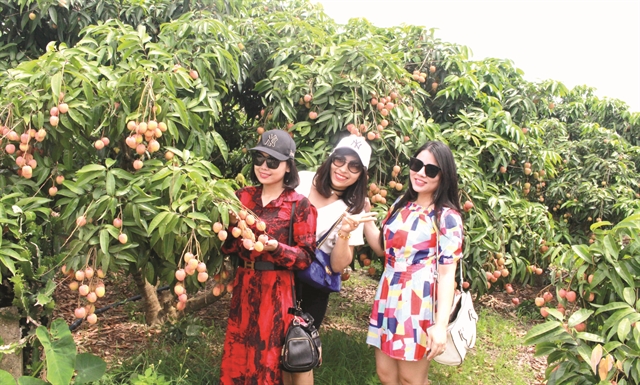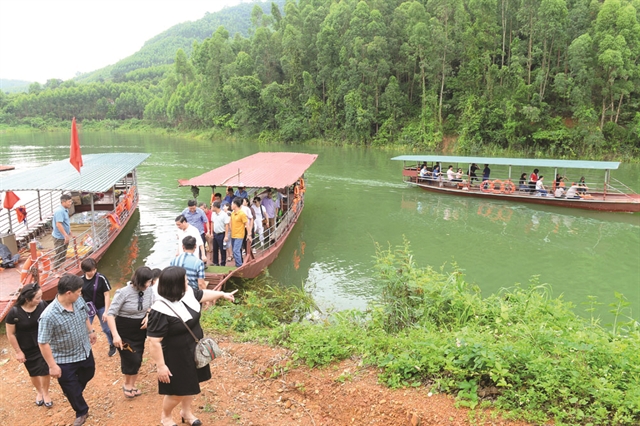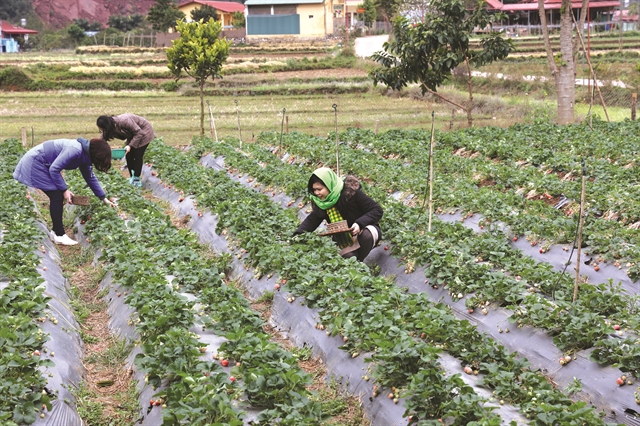By Thiên Hương
Việt Nam still has a long way to go if it wants to take full advantage of tourism to its undeveloped rural areas. Developing rural tourism could be an effective way to create more financial resources for new rural areas and more income for locals.
In many ways, rural tourism is still a relatively fresh idea, with eco-tourism and community-based tourism becoming increasingly popular throughout the country.
Small and spontaneous
After 10 years of applying the new rural areas policy, more than 5,700 communes have reached new standards, accounting for nearly 70 per cent of the communes in the country.

Visitors at a lychee garden in Lục Ngạn District, Bắc Giang Province. VNA/VNS Photo Đồng Thúy
The appearance of rural areas has changed significantly.
Muối Village in Giáp Sơn Commune, in Lục Ngạn District, Bắc Giang Province, which reached the standard for new rural areas in 2017, is an obvious example.
Though local living has been much-improved thanks to planting local speciality lychees, tourism facilities have remained modest.
Chu Xuân Ba’s family has over 2ha of lychee and 0.5ha of longan, following VietGAP and GlobalGAP standards.
He has started offering tourism services based on his family’s orchards.
“We have received visitors here to pick fruit in our gardens,” he says. “Yet, we have done it in a way we think is good. We haven’t got any training in tourism skills.”
Ba says he wants to develop tourism to advertise his lychee farm to sell more of the luscious fruit.
According to Vi Văn Tư, an official of Muối Village, there are some 400 households in the village, most of whom are of the Sán Dìu ethnic minority group.
“On average, each family has 1ha of lychee,” he says. “All of them plant lychee trees following VietGAP standard while some follow GlobalGAP.
Tư says the village aims to develop tourism with cultural values.
“Yet we have many things to do to become professional in the field,” he says.
Khúc Thị Nga, deputy director of the An Phú Trade & Service Cooperative, says the cooperative is building up tours associated with visiting the lychee gardens and visiting nearby Cấm Sơn Lake.

A tour to Cấm Sơn Lake in Bắc Giang Province is ideal for a day tour as there are no accommodations in the area available yet. VNA/VNS Photo Đồng Thúy
“However, the services are at the beginning,” she says. “Farmers have focused mostly on agriculture and have not offered supportive services like a guide on the process to care, nurture and harvest lychees,” she says.
Nga says that in the middle of Cấm Sơn Lake, there is an island with a camping site for visitors.
Local farmers’ boats are used to carry guests but do not meet tourism standards.
She says that the cooperative members have started to buy better boats that make less noise and has a more secure environment.
After visiting and examining tourism services in the village, Vũ Văn Tuyên, director of the Travelogy Việt Nam Tourism Company, says the local roads are reasonably good, but basic amenities like toilets and information services are very poor.
“Local authorities should have proper plan and guidance,” he says.
“Local farmers have got a good income from planting lychees. Yet they have not paid much attention to tourism services.”
Nguyễn Tiến Đạt, director of the AZA Tourism Company, says Lục Ngạn District, Bắc Giang Province, could become a tourism site with great potential. The locality also has good scenery and heritage sites.

Visitors pick strawberries at a garden in Vạt Village, Mộc Châu District, Sơn La Province. VNS Photo Nguyễn Nam
Đạt suggests a closer link between tourism enterprises and local companies to coordinate with locals to offer a unified procedure to receive guests.
Service quality
The agriculture tourism form is popular in the country and associated with ecological tourism.
Many localities like Quảng Nam Province and the Mekong River Delta have offered farm tourism.
Nguyễn Thị Thanh Hương, former general director of the Việt Nam National Administration of Tourism, says not only Bắc Giang but other localities planting fruit trees have been bogged down with difficulties when persuading garden owners to offer tourism services.
Hàm Yên District in Tuyên Quang Province, has the same problem.
“Farmers can get high profit from planting oranges, so they did not want to invest in tourism, which are rather high and get smaller profits than from orange planting,” she says.
“When being persuaded, only a few households join in tourism projects. They aim to advertise their products and cultural features.”
Hương says agritourism should be developed according to the national standard, offering visitors chances to understand the planting, caring and harvesting process.
“This should be offered together with chances for guests to work in the garden and then buy products,” she says. “Then the tourism service brings along profit and encourages local farmers to join in more."
Hương suggests choosing certain villages to start trial models to lure guests.
Nguyễn Quý Phương, chief of the Travel Department under the tourism administration, says since 2018, the administration has discussed agritourism.
The tourism authority noted that most agricultural activities had been conducted at a small scale, within limited areas, agricultural products had been of low quality, and the processing industry undeveloped.
“To make agricultural and rural tourism professional, we need proper spaces for agritourism activities, locals to act as service providers, and travel agencies to bring visitors to villages and share profit among participants,” Phương says.
Phạm Thị Hồng Thu, vice-chairperson of the provincial chapter of the Community Tourism Association, says the association has examined tourism facilities in Lục Ngạn (Bắc Giang) and found out that tourism facilities were still poor.
“There are too few hotels and only low-quality hostels,” she says.
Together with Mộc Châu District of Sơn La Province, Lục Ngạn District aims to form tourist sites in fruit farms and link with an ecological tour to Cấm Sơn Lake.
“The lake is beautiful, but there is no accommodation for guests,” she says. “Visitors can only have lunch on the island in the middle of the lake and go. So, Lục Ngạn is only suitable for visitors for a day.”
The Ministry of Agriculture & Rural Development has worked out a programme to develop rural tourism to build new rural areas from 2021 to 2025 at a total investment of VNĐ2.5 trillion (US$107 million).
The central government budget will spare some VNĐ500 billion; the localities budget will contribute VNĐ550 billion; programmes and projects will account for VNĐ560 billion, while other private contributions will make up some VNĐ890 billion.
Following the plan, by 2025, each province and city will have at least one recognised agricultural, rural tourism site based on local agrarian potential and handicraft villages.
At least 70 per cent of the owners of agritourism sites will get proper training in management skills. There should be a data foundation and digital maps of rural tourism sites in the country.
Hương says that building a new rural area programme in the past few years has upgraded and completed infrastructure, secured a hygienic environment, developed cultural values, and created handicraft villages, which will be a sustainable foundation for developing rural tourism.
“Rural tourism will only be awakened when locals love and take pride in the areas they live, products they create and cultural values they preserve,” she says.
“There should be unique tourism products, so visitors come, eat local delicacies, shop and use tourism services to create more jobs for locals.” VNS

Visitors take photos with a kapok tree in Yên Dũng District, Bắc Giang Province. VNA/VNS Photo Danh Lam
OVietnam